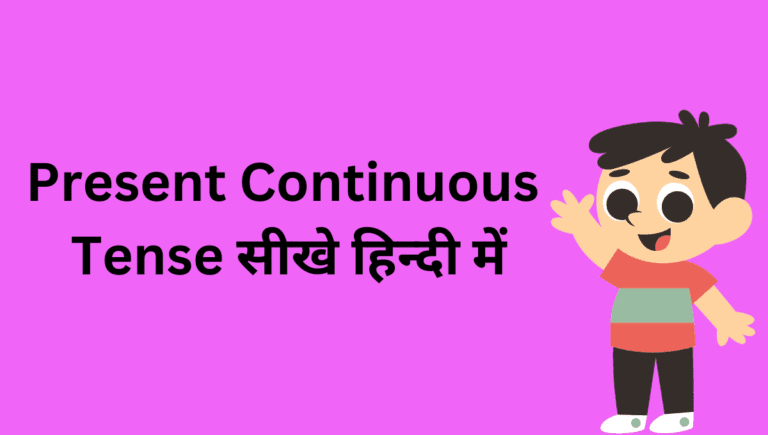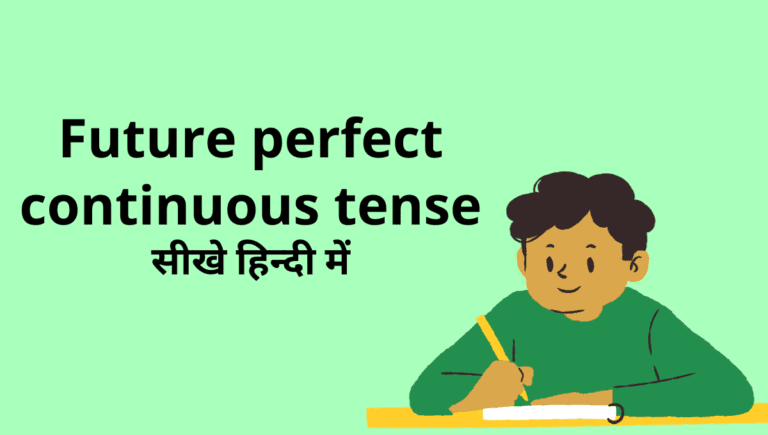हैलो दोस्तों इस पोस्ट में हम प्रेजेंट कंटीन्यूअस टेंस को हिन्दी में (present Continuous tense in Hindi) सीखेंगे। और साथ ही साथ present continuous tense के सूत्र (formula), नियम (rules) और वाक्यों में उदाहरण (sentences example) भी सीखेंगे। इससे पहले हमने Simple present tense सीखा था।
तो चलिए इस पोस्ट (present continuous tense in Hindi to English) में जानते है, कि present continuous tense क्या होते है। इनका उपयोग कब किया जाता है, और हम इनकी पहचान कैसे कर सकते है।
Present continuous tense in Hindi
Present continuous tense (अपूर्ण वर्तमानकाल), present tense (वर्तमान काल) का दूसरा tense (काल) है। जैसा कि आप नीचे देख सकते है:
वर्तमान काल (Present tense) के चार प्रकार-
- Simple present tense (सामान्य वर्तमानकाल)
- Present continuous tense (अपूर्ण वर्तमानकाल)
- Present perfect tense (पूर्ण वर्तमानकाल)
- Present perfect continuous tense (पूर्ण-अपूर्ण वर्तमानकाल)
Present continuous tense की परिभाषा
अपूर्ण वर्तमानकाल की परिभाषा – वह काल (tense) जिसमें कार्य वर्तमानकाल में लगातार होता रहता है। तथा कार्य प्रारंभ होने का समय नहीं दिया जाता है। उस काल (tense) को present continuous tense (अपूर्ण वर्तमानकाल) कहते है।
जैसे-
- Ram is going to market. (राम बाजार जा रहा है।)
- We are playing football. (हम फुटबॉल खेल रहे हैं।)
Note: Present continuous tense (अपूर्ण वर्तमानकाल) को present progressive tense (वर्तमान निरंतर काल) भी कहा जाता है।
Present continuous tense meaning in Hindi
प्रेजेंट कंटीन्यूअस टेंस (Present continuous tense) का हिंदी अर्थ होता है- “अपूर्ण वर्तमानकाल”।
Present continuous tense कि पहचान
जिन हिन्दी वाक्यों के अंत में रहा है, रही है, रहे है, आदि शब्दों का प्रयोग किया जाता है। वहाँ Present continuous tense होता है। इस टेन्स में कार्य हमेशा वर्तमान समय मे निरंतर चलता रहता है।
सामान्य शब्दों में कहे तो present continuous tense के वाक्यों में कार्य लगातार वर्तमान समय में होता रहता है। जैसे- “भानु खाना खा रहा है।” इस वाक्य में भानु अभी वर्तमान में खाना खा रहा है। अर्थात कार्य वर्तमान समय में लगातार हो रहा है।
Present continuous tense का उपयोग
अपूर्ण वर्तमानकाल (present continuous tense) का उपयोग करते समय हमें निम्न बातों का ध्यान रखना चाहिए:
- इस टेन्स में verb की 1st form के साथ ing का उपयोग किया जाता है।
- इस टेन्स में कार्य वर्तमान समय में लगातार होता है।
- इस टेन्स में कार्य के शुरू होने का समय नहीं दिया जाता है।
- इस टेन्स में verb 1st form और ing के साथ is, am, are सहायक क्रिया (helping verbs) का उपयोग किया जाता है।
Note: Is/am/are सहायक क्रियाएं (helping verbs) है, जिनका उपयोग इस प्रकार किया जाता है:
- Is – He, she, it, name, और एकवचन संज्ञा (singular noun) के साथ।
- Am – I (Am का प्रयोग केवल I के साथ किया जाता है।)
- Are – We, you, they, और बहुवचन संज्ञा (plural noun) के साथ।
Present continuous tense के formulas

Subject + is/am/are + verb 1st form + ing + object. (for positive sentence)
Subject + is/am/are + not + verb 1st form + ing + object. (for negative sentence)
Is/am/are + subject + verb 1st form + ing + object? (for interrogative sentence)
Is/am/are + subject + not + verb 1st form + ing + object? (for interro-negative sentence)
{Or}
Is/am/are + not + subject + verb 1st form + ing + object? (for interro-negative sentence)
Types of sentences in present continuous tense
Present continuous tense के वाक्यों को चार भागों में बाँटा जा सकता है:
- Positive sentence (सकारात्मक वाक्य)
- Negative sentence (नकारात्मक वाक्य)
- Interrogative sentence (प्रश्नवाचक वाक्य)
- Negative Interrogative sentence (नकारात्मक प्रश्नवाचक वाक्य)
Positive sentence
Formula
Subject + is/am/are + verb 1st form + ing + object.
Example in Hindi and English
1.) हम सब्जी खरीदने बाजार जा रहे है।
1.) We are going to the market to buy vegetables.
2.) वह मैदान पर दौड़ रहा है।
2.) He is running on the ground.
3.) मै मोबाईल चला रहा हूँ।
3.) I am using a mobile.
4.) भारतीय खिलाड़ी हॉकी खेल रहे है।
4.) Indian players are playing hockey.
5.) मम्मी चाय बना रही है।
5.) Mom is making tea.
6.) मजदूर कठिन परिश्रम कर रहे है।
6.) Labors are doing hard work.
7.) रोहित पानी पी रहा है।
7.) Rohit is drinking water.
ऊपर दिए गए वाक्यों में हमने Is/am/are और verb की 1st form के साथ ing का उपयोग किया है।
Negative sentence
Formula
Subject + is/am/are + not + verb 1st form + ing + object.
Example in Hindi and English
1.) हम बाजार सब्जी खरीदने नहीं जा रहे है।
1.) We are not going to the market to buy vegetables.
2.) वह मैदान पर नहीं दौड़ रहा है।
2.) He is not running on the ground.
3.) मैं मोबाइल नहीं चला रहा हूं।
3.) I am not using mobile.
4.) भारतीय खिलाड़ी हॉकी नहीं खेल रहे है।
4.) Indian players are not playing hockey.
5.) मम्मी चाय नहीं बना रही है।
5.) Mom is not making tea.
6.) मजदूर कठिन परिक्षम नहीं कर रहे है।
6.) Labors are not doing hard work.
7.) रोहित पानी नहीं पी रहा है।
7.) Rohit is not drinking water.
ऊपर दिए गए वाक्यों में हमने Is/am/are और verb की 1st form के साथ ing और not का उपयोग किया है।
Interrogative sentence
इस टेन्स में Interrogative sentence में 2 प्रकार के वाक्य बनते है:
- Is/am/are के साथ- जब वाक्य में “क्या” का भाव आता हो, और जवाब हाँ या ना में हो।
- WH words के साथ– जब वाक्य में “क्या” के अतिरिक्त कोई और प्रशनवाचक शब्द आता हो, जैसे: what, why, when, who etc.
अगर आप नहीं जानते की Wh words क्या है, तो आप इस लिंक 👉 wh words पर जाकर पढ़ सकते है।
Note- Interrogative sentence में हमेशा प्रश्नवाचक चिन्ह (?) लगता है।
Type-1 (Is/am/are)
Formula
Is/am/are + subject + verb 1st form + ing + object?
Example in Hindi and English
1.) क्या हम बाजार सब्जी खरीदने जा रहे है?
1.) Are we going to the market to buy vegetables?
2.) क्या वह मैदान पर दौड़ रहा है?
2.) Is he running on the ground?
3.) क्या मैं मोबाइल चला रहा हूं?
3.) Am I using mobile?
4.) क्या भारतीय खिलाड़ी हॉकी खेल रहे है?
4.) Are indian players playing hockey?
5.) क्या मम्मी चाय बना रही है?
5.) Is mom making the tea?
6.) क्या मजदूर कठिन परिश्रम कर रहे है?
6.) Are labors doing hard work?
7.) क्या रोहित पानी पी रहा है?
7.) Is Rohit drinking water?
ऊपर दिए गए वाक्यों में हमने Is/am/are और verb की 1st form के साथ ing का उपयोग किया है, और अंत में प्रश्नवाचक चिन्ह(?) लगाया है।
Type-2 (WH words)
Formula
Wh words + is/am/are + subject + verb 1st form + ing + object?
Example in Hindi and English
1.) हम बाजार क्यों जा रहे है?
1.) Why are we going to the market?
2.) वह कहां पर दौड़ रहा है?
2.) Where is he running?
3.) तुम किसका मोबाइल चला रहे हो?
3.) Whose mobile are you using?
4.) भारतीय खिलाड़ी कब हॉकी खेल रहे है?
4.) When are Indian players playing hockey?
5.) राखी क्या बना रही है?
5.) What is Rakhi making?
6.) मजदूर कैसे काम कर रहे है?
6.) How are the workers working?
7.) रोहित किस बर्तन से पानी पी रहा है?
7.) From which vessel is Rohit drinking water?
ऊपर दिए गए वाक्यों में हमने wh words और Is/am/are के साथ verb’s 1st+ing का उपयोग किया है, और अंत में प्रश्नवाचक चिन्ह(?) लगाया है।
Negative interrogative sentence
Interrogative sentence की तरह ही negative interrogative sentence में भी 2 प्रकार के वाक्य बनते है:
- Type-1 (Is/am/are के साथ)- जब वाक्य में “क्या” का भाव आता हो, और जवाब हाँ या ना में हो।
- Type-2 (WH words के साथ)– जब वाक्य में “क्या” के अतिरिक्त कोई और प्रशनवाचक शब्द आता हो, जैसे: what, why, when, who etc.
Note-
- Negative interrogative sentence में हमेशा प्रश्नवाचक चिन्ह (?) लगता है।
- Negative interogative sentence को interro-negative sentense भी कहते है।
Type-1 (Is/am/are + not)
Formula
Is/am/are + subject + not + verb 1st form + ing + object?
{Or}
Is/am/are + not + subject + verb 1st form + ing + object?
Example in Hindi and English
1.) क्या हम बाजार सब्जी खरीदने नहीं जा रहे है?
1.) Are we not going to the market to buy vegetables?
2.) क्या वह मैदान पर नहीं दौड़ रहा है?
2.) Is he not running on the ground?
3.) क्या मैं मोबाइल नहीं चला रहा हूं?
3.) Am I not using mobile?
4.) क्या भारतीय खिलाड़ी हॉकी नहीं खेल रहे है?
4.) Are indian players not playing hockey?
5.) क्या मम्मी चाय नहीं बना रही है?
5.) Is mom not making tea?
6.) क्या मजदूर कठिन परिश्रम नहीं कर रहे है?
6.) Are labors not doing hard work?
7.) क्या रोहित पानी नहीं पी रहा है?
7.) Is Rohit not drinking water?
ऊपर दिए गए वाक्यों में हमने Is/am/are और verb की 1st form के साथ ing और not का उपयोग किया है, और अंत में प्रश्नवाचक चिन्ह(?) लगाया है।
Type-2 (Wh words + not)
Formula
Wh words + is/am/are + subject + not + verb 1st form + ing + object?
{Or}
Wh words + is/am/are + not + subject + verb 1st form + ing + object?
Example in Hindi and English
1.) हम बाजार सब्जी खरीदने क्यों नहीं जा रहे है?
1.) Why are we not going to the market to buy vegetables?
2.) वह कहां पर नहीं दौड़ रहा है?
2.) Where is he not running?
3.) वह क्या नहीं चला रहा हूं?
3.) What he isn’t using?
4.) भारतीय खिलाड़ी हॉकी कैसे नहीं खेल रहे है?
4.) How are Indian players not playing hockey?
5.) मम्मी कब चाय नहीं बना रही है?
5.) When Is mom not making tea?
6.) मजदूर कठिन परिश्रम क्यों नहीं कर रहे है?
6.) Why workers aren’t working hard?
7.) रोहित पानी कहां नहीं पी रहा है?
7.) Where is Rohit not drinking water?
ऊपर दिए गए वाक्यों में हमने wh words, Is/am/are के साथ verb’s 1st form + ing और not का उपयोग किया है, और अंत में प्रश्नवाचक चिन्ह(?) लगाया है।
Present continuous tense examples in Hindi
नीचे आपको कुछ ओर प्रेजेंट कंटीन्यूअस टेंस के हिन्दी उदाहरण (present continuous tense examples in Hindi) दिये गये है:
1.) वे एक दूसरे से बातचीत कर रहे है।
1.) They are talking to each other.
2.) रानी अपने पसंदीदा गाने पर नाच रही है।
2.) Rani is dancing to her favorite song.
3.) पुलिस इस मामले में जांच नहीं कर रही है।
3.) Police is not investigating in this case.
4.) वह भगवान से प्रार्थना कर रहा है।
4.) He is praying to God.
5.) मेरे दोस्त साथ में क्रिकेट मैच देख रहे है।
5.) My friends are watching cricket match together.
6.) दुकानदार सामान बेच रहा है।
6.) Shopkeeper is selling the goods.
7.) पुजारी भगवान की पूजा कर रहा है।
7.) The priest is worshiping God.
8.) क्या वह तुम्हें परेशान कर रहा है?
8.) Is he bothering you?
9.) वह आज बहुत खुश महसूस कर रही है।
9.) She is feeling very happy today.
10.) मै इंटरनेट की मदद से टेंस सीख रहा हूँ।
10.) I am learning tense with the help of internet.
Present continuous tense FAQs
Present continuous tense का हिंदी अर्थ होता है- “अपूर्ण वर्तमानकाल”।
Present continuous tense की सहायक क्रियाएं “is, am, are” है।
और इनका उपयोग इस प्रकार किया जाता है –
Is – He, she, it, name, और एकवचन संज्ञा (singular noun) के साथ
Am – I (Am का प्रयोग केवल I के साथ किया जाता है।)
Are – We, you, they, और बहुवचन संज्ञा (plural noun) के साथ
जिन हिन्दी वाक्यों के अंत में रहा है, रही है, रहे है आदि शब्द आते है, तथा वाक्य के वर्तमान में लगातार होने का पता लगता है। वहाँ Present continuous tense (अपूर्ण वर्तमानकाल) होता है।
अपूर्ण वर्तमानकाल (Present continuous tense) का दूसरा नाम present progressive tense (प्रेजेंट प्रोग्रेसिव टेंस) है।
Conclusion
दोस्तों इस पोस्ट में हमने प्रेजेंट कंटीन्यूअस टेंस को हिन्दी से अंग्रेजी में (present continuous tense in Hindi to English) सीखा। और साथ में प्रेजेंट कंटीन्यूअस टेंस के कुछ example भी देखे।
हमे आशा है, की आपको यह पोस्ट (present continuous tense in Hindi) पसंद आयी होगी। आपको यह पोस्ट कैसी लगी हमें कमेन्ट में जरूर बताए। अगर आपका इस पोस्ट से संबंधित कोई सवाल या सुझाव हो तो आप कमेन्ट में पूछ सकते है।
Present Tense (वर्तमानकाल)




